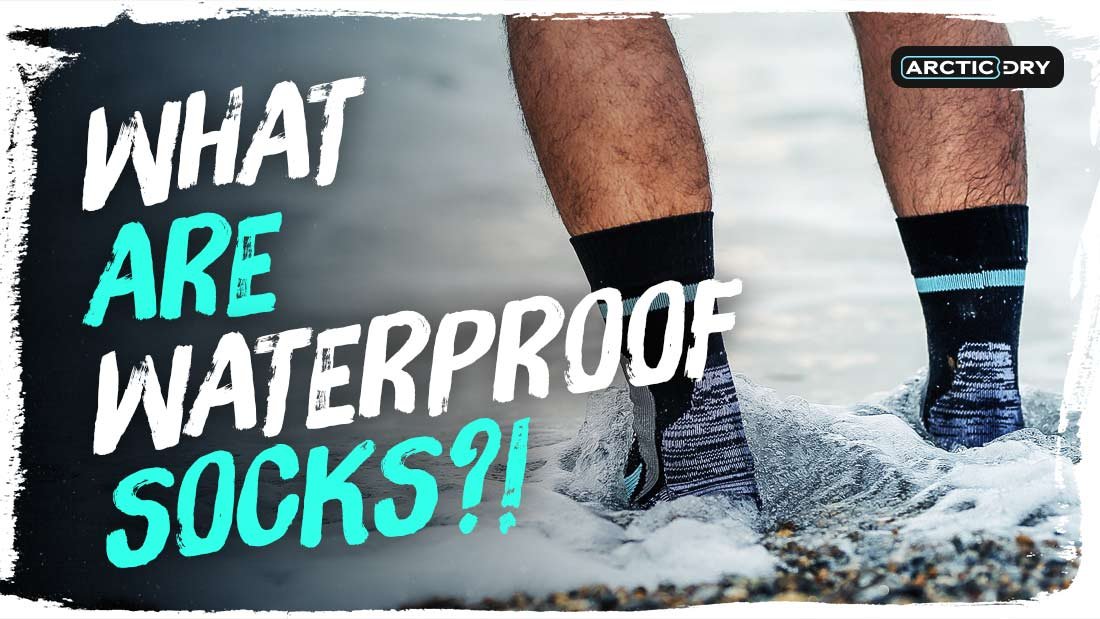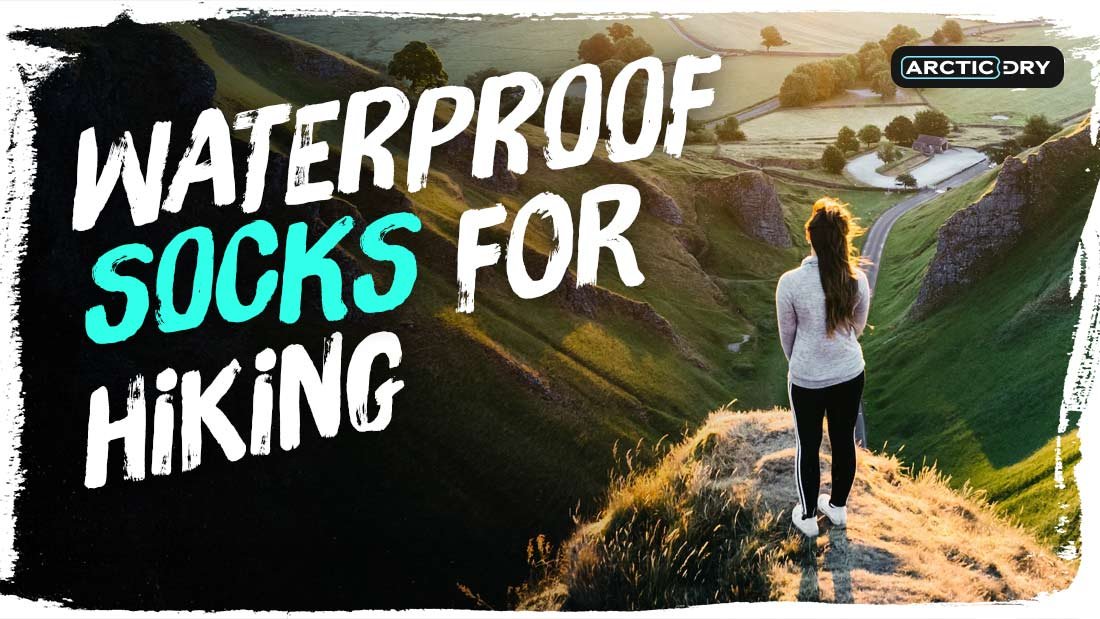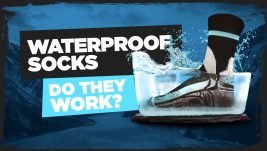What are Waterproof Socks?

Waterproof socks are an essential piece of gear for anyone who spends time outdoors in wet conditions. Whether you’re hiking in the rain in the peak district, fishing in a stream, or working in a wet environment, waterproof socks can keep your feet dry and comfortable. In this article, we’ll take a closer look at waterproof socks, including their construction, features, and benefits.
First, let’s define what waterproof socks are…
Waterproof socks are designed to prevent water from seeping into the sock, while still allowing moisture to escape. This means that your feet will stay dry, even in wet conditions.
Waterproof socks are typically made from a combination of materials, including synthetic fabrics like polyester and nylon, as well as waterproof membranes like Gore-Tex or Porelle. These materials work together to create a barrier that keeps water out, while still allowing moisture to escape.
One of the key features of waterproof socks is their breathability. In order for your feet to stay comfortable, moisture needs to be able to escape from the sock. Without breathability, your feet will quickly become sweaty and clammy, leading to discomfort and potentially blisters. Waterproof socks are designed to allow moisture to escape, so your feet stay dry and comfortable.
Another important feature of waterproof socks is durability. These socks need to be able to withstand the rigors of outdoor activities, including hiking, fishing, and other outdoor sports. Waterproof socks are typically made from high-quality materials, such as synthetic fabrics and waterproof membranes, which are designed to withstand abrasion and wear.
One of the main benefits of waterproof socks is that they keep your feet dry. This is especially important in wet conditions, where your feet are at risk of getting wet and cold.
Waterproof socks will keep your feet dry, even in the wettest conditions, so you can stay comfortable and focused on your outdoor activities, whether you’re in the lake district or you’re out golfing.
Another benefit of waterproof socks is their breathability. As mentioned earlier, breathability is essential for keeping your feet comfortable in wet conditions. Waterproof socks are designed to allow moisture to escape, so your feet stay dry and comfortable. This is especially important when you’re engaging in activities that require a lot of movement, such as hiking or running.
Another benefit of waterproof socks is their durability. As mentioned earlier, waterproof socks are made from high-quality materials that are designed to withstand the rigors of outdoor activities. This means that they will last longer and provide better protection for your feet, even in the most demanding conditions.
There are a few different types of waterproof socks on the market which are slightly different to ArcticDry Waterproof Socks, each designed for specific activities and environments. Here are some of the most common uses for waterproof socks:
Hiking socks: Hiking socks are designed for use on the trail. These socks are typically mid-weight, providing warmth and moisture wicking properties. They are often made from a combination of synthetic fabrics and waterproof membranes, providing both breathability and waterproof protection.
Fishing socks: Fishing socks are designed for use on the water. These socks are typically lightweight, providing maximum breathability and moisture wicking properties. They are often made from a combination of synthetic fabrics and waterproof membranes, providing both breathability and waterproof protection.
Work socks: Work socks are designed for use in wet environments, such as construction sites or agricultural settings. These socks are typically heavy-duty, providing maximum protection against water and abrasion. They are often made from a combination of synthetic fabrics and waterproof membranes, providing both breathability and waterproof protection.
Waterproof breathable socks: Breathable waterproof socks, such as the ones we create here at ArcticDry are designed to keep your feet dry and comfortable in wet conditions, with a breathable membrane that allows moisture to escape from your feet while preventing water from entering.
Waterproof liner socks: These socks are designed to be worn under your regular socks, providing an extra layer of waterproof protection for your feet. They are typically thinner than other types of waterproof socks, allowing them to be worn comfortably without adding too much bulk or weight to your feet.
Regardless of the type of waterproof socks you choose, it is important to select a pair that is the right size and fit for your feet. Waterproof socks should fit snugly and comfortably, without being too tight or restrictive.
When trying on a pair of waterproof socks, be sure to wear them with the same type of shoes or boots that you will be using in wet conditions. This will help you to determine whether the socks fit properly and provide the right level of protection for your feet.
It is also important to take care of your waterproof socks to ensure that they continue to provide maximum protection and performance. To do this, you should:
Wash your waterproof socks regularly: It is important to wash your waterproof socks regularly to remove any dirt, sweat, or debris that can build up over time. This will help to prevent any unpleasant odors and keep your socks in good condition.
Waterproof socks for hiking:

Hiking is a popular outdoor activity that many people enjoy. It allows them to explore the great outdoors and experience the beauty of nature. However, one of the challenges that hikers face is wet feet. Wet feet can cause discomfort and even lead to blisters, making the hike less enjoyable. That is why it is important for hikers to invest in waterproof socks.
Waterproof socks are designed to keep your feet dry and comfortable even in wet conditions. They are made of materials that are resistant to water and moisture, such as Gore-Tex or neoprene. These materials allow the socks to repel water while still allowing your feet to breathe.
One of the benefits of waterproof socks is that they provide an extra layer of protection for your feet. When you are hiking in wet conditions, your feet are exposed to the elements. Water can seep into your shoes and socks, causing your feet to get wet and cold. This can lead to discomfort and even blisters. Waterproof socks can provide an extra barrier between your feet and the water, helping to keep them dry and comfortable.
Another benefit of waterproof socks is that they can help to keep your feet warm. Wet feet are more prone to getting cold, which can lead to discomfort and even hypothermia. Waterproof socks can help to trap heat, keeping your feet warm even in wet conditions. This is especially important in cold weather or if you are hiking at high altitudes where the temperature is lower.
Waterproof socks are also great for hikers who are crossing streams or rivers during their hike. When you are crossing water, your feet are exposed to the water. This can lead to wet and cold feet, which can be uncomfortable and even dangerous. Waterproof socks can provide an extra layer of protection for your feet, keeping them dry and warm as you cross the water.
There are a few different types of waterproof socks that are available for hikers. The type of sock that you choose will depend on your personal preferences and the conditions that you will be hiking in.
One popular type of waterproof sock is the neoprene sock. Neoprene is a synthetic rubber that is resistant to water and moisture. It is also flexible and comfortable to wear. Neoprene socks are great for hiking in wet conditions because they provide an extra layer of protection for your feet. They are also lightweight and easy to pack, making them a convenient option for hikers.
Another popular type of waterproof sock is the Gore-Tex sock. Gore-Tex is a breathable and waterproof material that is commonly used in outdoor clothing and gear. It is a durable and reliable material that is resistant to water and moisture. Gore-Tex socks are great for hiking because they provide an extra layer of protection for your feet while still allowing them to breathe.
There are also waterproof socks that are made of other materials, such as polyester and nylon. These materials are not as breathable as Gore-Tex or neoprene, but they are still resistant to water and moisture. They are a good option for hikers who are looking for a more affordable waterproof sock.
When choosing waterproof socks for hiking, it is important to consider the conditions that you will be hiking in. If you are hiking in wet conditions, you will want a sock that is made of a waterproof and breathable material, such as Gore-Tex or neoprene. If you are hiking in dry conditions, you may be able to get away with a sock made of a less breathable material, such as polyester or nylon.
It is also important to consider the fit of the sock. Waterproof socks should fit snugly on your feet without being too tight. They should also provide enough padding to protect your feet








